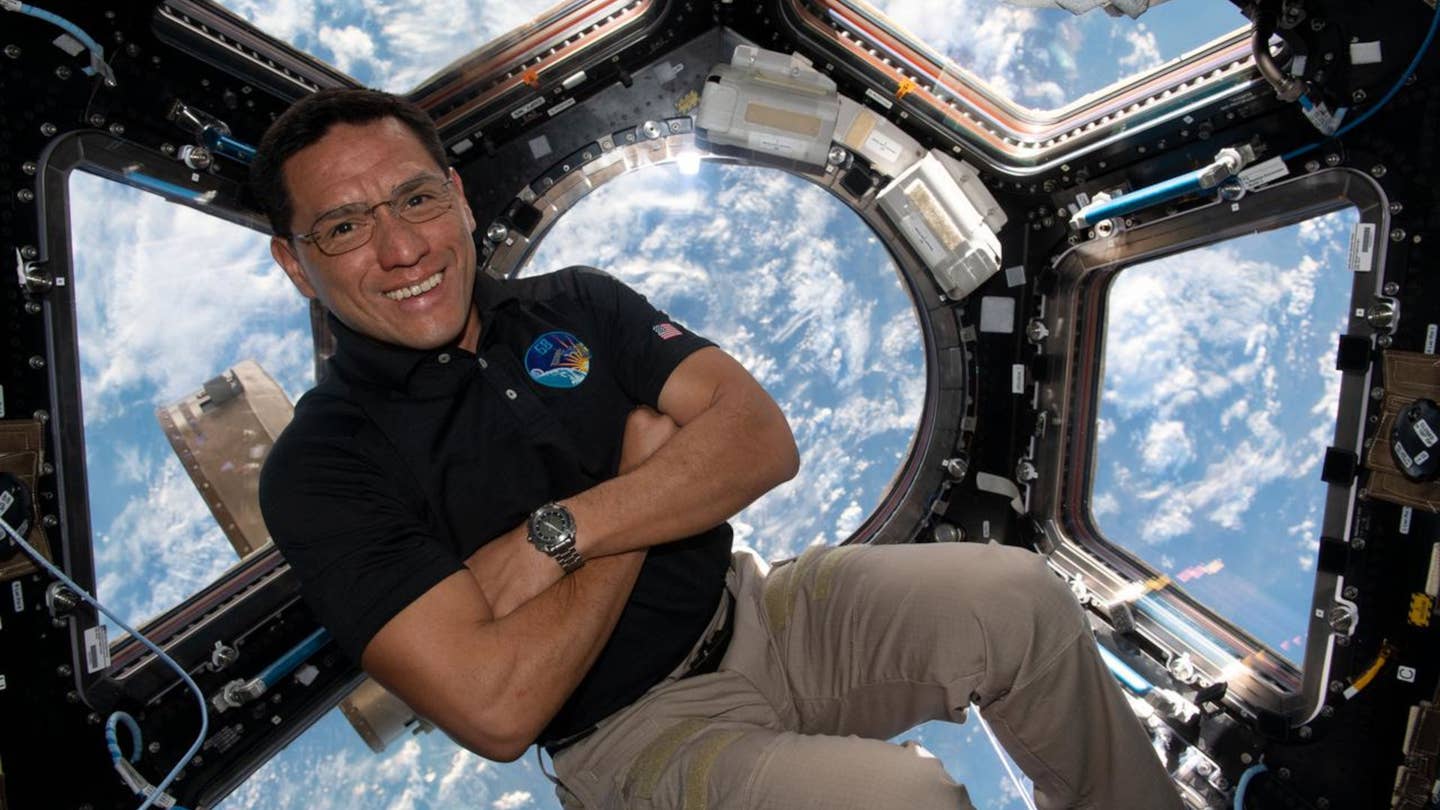NASA Astronaut Sets U.S. Spaceflight Record with Yearlong Mission
Frank Rubio’s 355 consecutive days aboard the International Space Station are an American milestone—not bad for his first trip to space.

NASA astronaut Frank Rubio, the new record holder for the longest U.S. space mission. [Courtesy: NASA]
For a NASA astronaut stranded on the International Space Station for months, there are some silver linings: namely, a pair of U.S. spaceflight records.
Frank Rubio, who departed for the space station on his first astronaut mission in September 2022, now holds the record for the most consecutive days spent aboard the orbital hub, besting the previous mark of 355 days, 3 hours, and 45 minutes set by retired astronaut Mark Vande Hei in 2022, NASA said in a statement on social media. Rubio’s scheduled six-month stay was more than doubled when the capsule that brought him to the space station was damaged.
By the end of his mission, the former flight surgeon, who flew more than 1,100 hours as a UH-60 Blackhawk helicopter pilot deployed to Bosnia, Afghanistan, and Iraq, will have spent 371 days in orbit, marking the single longest mission for a NASA astronaut. That will make Rubio one of just seven people—and the first American—to spend one consecutive year in space.
Rubio, raised in El Salvador by Salvadoran parents, is also the first person of that country’s origin to reach the final frontier.
“It's an honor to be able to be considered one of the people that's going to have spent a year in space,” said Rubio in a recent interview with ABC's Good Morning America. “And for sure this record will soon be broken again.”
Rubio is set to return to Earth on September 27 aboard a Russian Soyuz capsule. It will likely take some time for him to reacclimate.
“After about six months in space, most people have a little bit of a hard time with their vestibular system and their equilibrium. So after 12 months that can be a challenge,” he said. “It might take a couple of days before I'm somewhat normal, but the reality is it's going to take anywhere from two to six months of really intense rehab to get back to my normal, and that's just part of the process.”
Following NASA’s announcement of his prestigious new titles, Rubio was immediately showered with praise by current and former astronauts. NASA Administrator Bill Nelson, who traveled to space aboard the space shuttle Columbia in 1986, was among them.
“Frank Rubio's journey in space embodies the essence of exploration,” Nelson posted on X, formerly known as Twitter. “As he breaks records as the longest serving @NASA US astronaut in space, he also paves the way for future generations of astronauts. Your dedication is truly out of this world, Frank!”
Nelson and NASA deputy administrator Pam Melroy will make an Earth-to-space call Wednesday at 12:05 p.m. EDT to chat with Rubio about his time on the space station. It’ll be broadcast live on NASA TV.
When Rubio completes his mission later this month, he’ll become one of the most prolific space travelers in human history. But he won’t quite set the record for the longest human space mission. That honor belongs to Russian cosmonaut Valeri Polyakov, who spent 437 days straight aboard the Russian space station Mir.
Another Russian, Gennadi Padalka, owns the record for most cumulative days in space with a total of 879 over five spaceflights. Retired NASA astronaut Peggy Whitson is the U.S. leader with 675 days, extending her lead in May after commanding the Axiom Space Ax-2 mission as a private astronaut.
Not Quite According to Plan
When Rubio strapped himself into a Russian Soyuz capsule last September, he was prepared for a long stay: six months aboard the space station. But he couldn’t have predicted what happened next.
As part of a crew-swapping agreement between NASA and the Russian space agency Roscosmos, Rubio and cosmonauts Sergey Prokopyev and Dmitri Petelin traveled to the space station aboard the Soyuz MS-22 while cosmonaut Anna Kikina flew on a SpaceX Crew Dragon.
But in December, Roscosmos discovered the MS-22 capsule had sprung a coolant leak, likely due to an impact from a small meteorite. The agency deemed the spacecraft unsafe to carry Rubio, Prokopyev, and Petelin home as planned, and the three were stranded.
In February, Roscosmos sent out a replacement MS-23 rescue capsule, which docked with the space station later that month. Its return date was eventually set for September, giving the agency time to prepare the next Soyuz capsule, which is expected to launch with two cosmonauts and a NASA astronaut as soon as Friday.
Rubio, Prokopyev, and Petelin had originally planned to carry out research and experiments as part of NASA’s Expedition 67 and Expedition 68 crews, but the trio would end up joining Expedition 69 as well. Their departure later this month will mark the beginning of Expedition 70.
“We've been up here for six months. Frank thought when he flew to space, he would be here for six months. And partway through his mission, he found out that it was extended to a year,” said Woody Hoburg, whose time on the space station overlapped with Rubio’s as part of NASA’s Crew-6 mission. Hoburg and three other astronauts splashed down last week after spending 186 days on the space station.
“His leadership up here has been incredible,” Hoburg added. “He's been amazing to work with. And Frank is just making a huge sacrifice being away from his family for so long.”
The Crew-7 mission, Crew-6’s successor, also arrived on the orbital base during Rubio’s stay. NASA last month released crew assignments for Crew-8, which is scheduled to launch early next year.
Like this story? We think you'll also like the Future of FLYING newsletter sent every Thursday afternoon. Sign up now.

Subscribe to Our Newsletter
Get the latest FLYING stories delivered directly to your inbox






